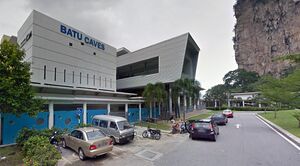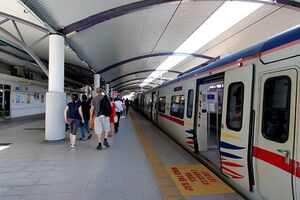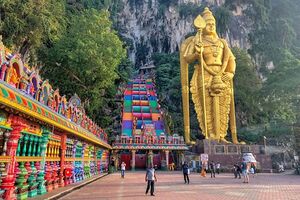Batu
| Batu | |||||
|---|---|---|---|---|---|
| Japanese Name | バトゥ | ||||
| Weapon | |||||
| Race | Human | ||||
| Nationality | |||||
| Birthday | November 1 | ||||
| Constellation | Scorpio | ||||
| Talents | Combat | ||||
| Likes | Fighting | ||||
| Dislikes | Arguing | ||||
| Strengths | Not disliking people without reason | ||||
| Weaknesses | Short temper, Recklessness due to her high pain tolerance | ||||
| Hobbies | Appreciating and creating works of art | ||||
I'm Batu. I come from a place called Skanda Cave in Flamarine. I've been friends with Putra since we were kids. But then again, I've been so busy with work with the Skanda Mercenaries for the longest time. We didn't have that much time to play together. But anyway, I love fighting. Make sure you put me right on the front lines.
Layers
| Icon | Title | Release Date | Where to Obtain |
|---|---|---|---|
| [The Heir Apparent] Batu | 2024 March 8 | [Training Camp - Batu] Event Reward | |
| [Painless Mercenary] Batu | 2022 March 16 (EN) | Mist Train Girls ~ From the Window of the Mist World Novel 1 - Serial Code | |
| [Promise to Protect You] Batu | 2022 May 23 | [Subterranean Noble and the Dancing Crane Under the Moonlight] Limited Gacha | |
| [Peerless Battle Princess] Batu | 2022 October 7 | Tower Ticket Gacha, Panel Mission | |
| [No Enemies in the Sea] Batu | 2024 February 29 | [Fishing Legend Ayala 2 ~Love - Do You Remember It‽~] Pick Up Gacha, Premium Gacha |
Skills
Trivia
- Batu's birthday is the opening date of the old Batu Caves station in 1905. It was abandoned without electrification and reopened on 29th July, 2010.
- Skanda is also known as Kartikeya, Kumara, Murugan, Shanmugha and Subrahmanya, is the Hindu god of war. He is a son of Parvati and Shiva, brother of Ganesha, and a god whose life story has many versions in Hinduism. An important deity in the Indian subcontinent since ancient times, Kartikeya is particularly popular and predominantly worshipped in South India, Sri Lanka, Singapore and Malaysia as Murugan.
- The Skanda Cave, base of operations of the mercenaries, is a giant limestone cave, which also mirrors the real life counterpart.
- Batu's childhood friend is Putra, referencing their close proximity of their real life counterparts in Malaysia.
- The adorned peacock feathers and her golden spear on [Peerless Battle Princess] references Skanda, the Indian God of War. Skanda is typically accompanied by a peacock, a bird associated with youthful fertility and swift aggression in battle.
- The wood-gold stairs and the cave entrance in the background of [Peerless Battle Princess] is the stairs in the inner chambers of Batu Caves in Malaysia.
- Mero (Burung) Merak is Malay for "Peahen".
Counterpart
The KTM Batu Caves Komuter Station, formerly known as Batu Caves Railway station (Stesen Keretapi Batu Caves) is located at Batu Caves, Gombak District, Selangor, Malaysia. served by regular KTM Komuter trains (commuter) that operate on the line between here and Pulau Sebang/Tampin, travelling through Kuala Lumpur city centre (KL Sentral Railway Station). Batu Caves railway station is classified as the terminal station on the Malaysian Railways Seremban Line (Laluan Seremban). The Batu Caves railway station was constructed on November 1, 1905 in Malaysia.
Over the years, the station fell into a poor condition through neglect and lack of use, and the village was deserted except during the annual Thaipusam Festival, where Hindu Devotees visit the nearby Batu Caves for their pilgrimage. The line between Sentul and Batu Caves was not included in the double-tracking and electrification of the line between Kuala Lumpur and Sentul under the Sixth Malaysia Plan (1990-1995). Since then, the station has been rebuilt and the line electrified. The existing single railway track between Sentul to Batu Caves was doubled, as well as new stations and halts, including Taman Wahyu KTM station, Kampung Batu KTM station, and Batu Kentonmen KTM station.
The project to reopen the Batu Caves Komuter station was scheduled to start before 2001, with DRB-Hicom Berhad as a contractor. The letter of intent was issued by the Transport Ministry to the company on 13 April 2001. However, no letter of award was issued and there was no progress until 17 November 2006 when site possession was given to contractor YTL Corporation. The project was expected to be completed by April 2010, but the new station's opening date was delayed to 1 August, 2010. Wikipedia
Batu Caves (பத்து மலை) is a limestone hill that has a series of caves and cave temples in Gombak, Selangor, Malaysia. It takes its name from the Malay word batu, meaning 'rock'. The hill was originally known as Kapal Tanggang from the legend of Si Tanggang. The town nearby is named after the Batu Caves limestone formation. The limestone forming Batu Caves is said to be around 400 million years old. Some of the cave entrances were used as shelters by the indigenous Temuan people (a tribe of Orang Asli).
Batu Caves in short also referred as 10th Caves or Hill for Lord Murugan as there are six important holy shrines in India and four more in Malaysia. The three others in Malaysia are Kallumalai Temple in Ipoh, Tanneermalai Temple in Penang and Sannasimalai Temple in Malacca. As early as 1860, Chinese settlers began excavating guano for fertilising their vegetable patches. However, they became famous only after the limestone hills were recorded by colonial authorities including Daly and Syers as well as American Naturalist, William Hornaday in 1878.
Batu Caves was promoted as a place of worship by K. Thamboosamy Pillai, an Indian Tamil trader. He was inspired by the vel-shaped entrance of the main cave and was inspired to dedicate a temple to Lord Murugan within the caves. In 1890, Pillai, who also founded the Sri Mahamariamman Temple, Kuala Lumpur, installed the murti (consecrated statue) of Sri Murugan Swami in what is today known as the Temple Cave. Since 1892, the Thaipusam festival in the Tamil month of Thai (which falls in late January/early February) has been celebrated there. Wikipedia
Map
Gallery
- Pages using Tabber parser tag
- Pages using DynamicPageList3 parser tag
- Weapon Spear
- Human
- Flamarine
- Scorpio
- Element Pierce
- Element Fire
- Element Wind
- Train Knights
- Malaysia



















